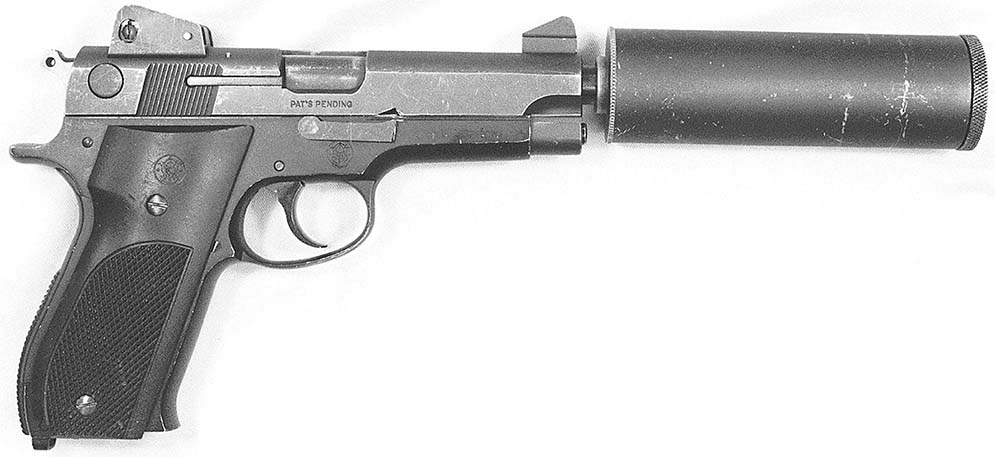Mark 23, right side.
By Kevin Dockery
Vietnam was the first war zone where the US forces began making real use of suppressed weapons in combat. All of the US services fielded some suppressed weapons at one time or another during the Vietnam War. Originally, the vast majority of these weapons were WWII designs that had been stored away since their use by the OSS during that conflict.
Since there was a stigma attached to suppressed weapons in combat, some high-ranking officers and politicians considered them just weapons for assassins, not combat soldiers. When the Navy SEALs asked for a suppressed handgun to be designed, the request was couched in careful terms. The need was voiced for a means of quietly eliminating guard dogs. The planned use for the new suppressed pistol resulted in its now famous nickname – the Hushpuppy.
Developed in the 1966-1967 time frame, the Hushpuppy was based on the Smith and Wesson Model 39. A longer barrel, higher sights, elimination of the magazine safety, and a few other changes were done to adapt the weapon to its new configuration.
The biggest change was the removal of the standard slide stop and its replacement with a special, extended version, the slide latch. The slide latch has a right and left side component, both of which have a raised triangular front tip. When the rear of the latch is depressed, the front tips engaged into triangular cuts on either side of the slide. With the slide latch engaging the cutouts in the slide, the action remains locked during firing. This makes the hushpuppy a single-shot, manual repeater, but also eliminates the sound of the action cycling when fired.
The new weapon was called the 9mm Pistol Mark 22 Mod 0. To suppress the sound of firing, the Mark 3 noise suppressor was designed. The Mark 3 suppressor is a simple muzzle can containing a spring retainer and suppressor insert. The insert is the heart of the suppression system.

Contained within the 2-inch sealed aluminum capsule of the suppressor insert are four spaced 1/4-inch thick soft urethane plastic disks. The first bullet passing through the insert makes the hole that the subsequent projectiles will pass through. When the sound of firing raises to an unacceptable level, or after 24 shots have been fired through it, the suppressor insert is simply replaced, effectively refurbishing the suppressor.
To maximize sound suppression of the admittedly specialized weapon, the Mark 144 9mm round was developed. The Mark 144 round was a special, heavy-bullet subsonic round. The green tip of the Mark 144 round indicated that it was loaded with a 158-grain full jacketed bullet that had a nominal muzzle velocity of 965 fps. The Mk 144 cartridge was reportedly developed under navy contract by the Super Vel cartridge company. The first production run was for 7,000 rounds, the second being for 12,000 rounds. By 1970, the Navy put out a bid for a further 30,000 rounds of Mk 144 ammunition, but this was picked up by other companies.

To refurbish the Hushpuppy in the field, the Navy packaged the Mark 26 9mm Pistol Accessory Kit Mark 26 Mod 0. Along with a new suppressor insert, the Mk 26 kit came complete with 24 rounds of Mk 144 ammunition. In addition to the ammunition and suppressor insert, the Mk 26 kit had specialized plugs, caps, and disks, that could be used to waterproof the Hushpuppy so that it could be transported underwater, either assembled or the pistol and suppressor separated, to a depth of 200 feet.
The chamber plug in the Mk 26 kit was a plastic “round” with am O-ring in the center of its body. With the chamber plug in place, and a white, plastic muzzle plug disk over the front of the Mk 3 suppressor, the Hushpuppy could be carried underwater assembled and sheathed in its holster.

Coming up to the surface, all a Navy SEAL would have to do is pull back the slide of the Hushpuppy, automatically ejecting the chamber plug. Slipping the slide forward would chamber one of the waterproofed Mk 144 rounds in the Hushpuppy’s magazine. The plastic muzzle plugs were designed to be safely fired through.
The Hushpuppy would put 8 shots into an 8-inch circle at 25 yards. Roughly converted from the original measurements, the sound of the unsuppressed Hushpuppy was 160-decibels, the sound of the unlocked suppressed pistol firing was 133 decibels. With the slide latch engaged and firing Mk 144 ammunition, the Hushpuppy had a peak sound pressure of 129 decibels. Usually, the target would never hear the shot.
All told, only between 100 and 120 Hushpuppies were ever made for the Navy. The SEALs first started fielding the new pistols in late 1967. By 1968, each deploying SEAL platoon had at least one Hushpuppy assigned to it. Production never really met the demand for the weapon. In 1970, SEAL Team Two acquired 45 more Hushpuppies to support their operations in Vietnam – they always wanted more.
| This article first appeared in Small Arms Review V5N9 (June 2002) |











